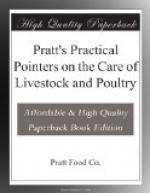Where suitable pasture may be obtained, it is usually a cheaper source of food for cows than soiling food or cured fodders, as the element of labor in giving the food is largely eliminated. The best pastures, viewed from the standpoint of production, are those grown on lands that may be irrigated during the season of growth. These consist of clover and certain grasses. Permanent pastures which are grown on moist land, and which contain a number of grasses, are usually satisfactory, but the nature of the pasture must, of course, be largely determined by the attendant conditions. Blue grass pastures are excellent while succulent and abundant, but in midsummer they lose their succulence for weeks in succession. Brouer grass is a favorite pasture in northwestern areas, and Bermuda grass in the South. In the Eastern and Central States, the most suitable pastures are made up of blue grass, timothy, and orchard grass, and of the common red, white and alsike clovers.
There is more or less of hazard to cows when grazing on alfalfa—liability to bloating, which may result fatally. Likewise second growth sorghum or the second growth of the non-saccharine sorghums is full of hazard, especially in dry seasons when it has become stunted in growth. Nor should rape and rye be grazed, save for a short time after the cows have been milked, lest they give a taint to the milk.
The change from winter rations to grazing should never be suddenly made, or purging caused by the fresh grass will lead to loss in weight and loss of milk, though at first there will probably be an advance in the same. The change may be made in outline as follows:
(1) The cows will not be turned out until after the food given in the morning has been sufficiently consumed.
(2) They will be kept out an hour, or two the first day, and the time increased.
(3) The time called for to effect the change should never be less than one week or more than three.
(4) As soon as the change begins, the reduction in succulent food, ensilage, and field roots should also begin.
(5) The dry fodder should be continued morning and evening as long as the cows will take it.
[Illustration: AYRSHIRE COW]
(6) There should be some reduction and it may be modification in the grain for a short time.
After turning out a full supply may be necessary. Should the pasture be composed mainly of grasses, food rich in protein, as wheat bran, should be fed, but if it is composed mainly of clover, then more carbonaceous grain, as corn, should be fed.
When pasture is succulent and abundant, it is a disputed point as to whether it will pay to feed meal of any kind in addition. The following conclusion in regard to this question would seem safe:
When cows are fed grain on pastures succulent and abundant, the tendency is to increase the yield in the milk and also to increase flesh.




